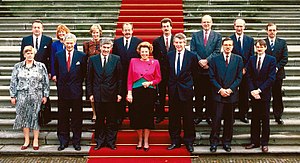
Back Lubbers III-kabinet Afrikaans Kabinett Lubbers III German Cabinet Lubbers III French Governo Lubbers III Italian Kabinet-Lubbers III Dutch Trzeci rząd Ruuda Lubbersa Polish
Third Lubbers cabinet Lubbers–Kok cabinet | |
|---|---|
61st Cabinet of the Netherlands | |
  The installation of the Third Lubbers cabinet on 7 November 1989 | |
| Date formed | 7 November 1989 |
| Date dissolved | 22 August 1994 4 years, 288 days in office (Demissionary from 10 May 1994) |
| People and organisations | |
| Monarch | Queen Beatrix |
| Prime Minister | Ruud Lubbers |
| Deputy Prime Minister | Wim Kok |
| No. of ministers | 14 |
| Ministers removed | 7 |
| Total no. of members | 19 |
| Member party | Christian Democratic Appeal (CDA) Labour Party (PvdA) |
| Status in legislature | Centrist Majority government (Grand coalition) |
| History | |
| Election | 1989 election |
| Outgoing election | 1994 election |
| Legislature terms | 1989–1994 |
| Incoming formation | 1989 formation |
| Outgoing formation | 1994 formation |
| Predecessor | Second Lubbers cabinet |
| Successor | First Kok cabinet |
| Part of the Politics series |
![Azure, billetty Or a lion with a coronet Or armed and langued Gules holding in his dexter paw a sword Argent hilted Or and in the sinister paw seven arrows Argent pointed and bound together Or. [The seven arrows stand for the seven provinces of the Union of Utrecht.] The shield is crowned with the (Dutch) royal crown and supported by two lions Or armed and langued gules. They stand on a scroll Azure with the text (Or) "Je Maintiendrai" (French for "I will maintain".)](http://upload.wikimedia.org/wikipedia/commons/thumb/8/8f/State_coat_of_arms_of_the_Netherlands.svg/150px-State_coat_of_arms_of_the_Netherlands.svg.png) |
|---|
|
|
The Third Lubbers cabinet, also called the Lubbers–Kok cabinet, was the executive branch of the Dutch government from 7 November 1989 to 22 August 1994. The cabinet was formed the christian-democratic Christian Democratic Appeal (CDA) and the social-democratic Labour Party (PvdA) after the election of 1989. The cabinet was a centrist grand coalition and had a substantial majority in the House of Representatives with Christian-Democratic Leader Ruud Lubbers serving as Prime Minister. Labour Leader Wim Kok served as Deputy Prime Minister and Minister of Finance.
The cabinet served during the final years of the turbulent 1980s and the early years of the economic boom of the 1990s. Domestically it focused on revitalizing the economy, reducing the deficit, and stimulating further deregulation and privatization. It had to deal with the El Al Flight 1862 Crash. Internationally the signing of the Maastricht Treaty took place but also it had to deal with several crises such as the beginning of the Bosnian War. The cabinet suffered several major internal conflicts including multiple resignations, but completed its entire term and was succeeded by the First Kok cabinet following the 1994 election.[1]
According to one study, “In a bid to placate the progressive wing of his party and to keep the Christian Democrats in the centre, Rudd Lubbers discarded the right-wing liberals (VVD) in 1989 as a coalition partner and invited the social democrats (PvdA) to partake in the third Lubbers cabinet (1989–1994).”[2]
- ^ "Rendement van een jaar kabinet Lubbers/Kok: 9,9 miljard voornieuw beleid" (in Dutch). NRC Handelsblad. 18 September 1990. Retrieved 13 February 2018.
- ^ The Rise of the Dutch New Right An Intellectual History of the Rightward Shift in Dutch Politics By Merijn Oudenampsen, 2020
© MMXXIII Rich X Search. We shall prevail. All rights reserved. Rich X Search